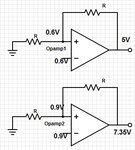sdmuashr
Junior Member level 1
Hi,
Background: The Opamp OPA547 is used in 2 identical but separate units of power supplies. One unit is functioning properly whereas the other one is defective. After comparison it was figured out that every pin of these two opamps has the same value/voltage except the input & output pins. There are 7 pins in the opamp.
Problem: The theory says that opamp just amplifies the difference in voltages applied at its input terminals. That is, if both inputs were of equal (i.e. 2mV & 2mV or 5mV & 5mV) values then the difference would be 0 and output would also be 0. However, what is noticed here is that one opamp with inputs (.6V & .6V) and the otherone with the inputs (0.9V & 0.9v) produce different outputs (instead of producing same voltage at the output). Please see the figure. Please also Keep in mind that all of the pins except for those mentioned in the figure are used but are not mentioned in the figure since they have the same values.

In case anyone interested further in knowing about the pin values then they are also mentioned in the following.
Opamp 1
1: 0.6v
2: 0.6v
3: -5V
4: -5V
5: 10.2V
6: 5v
7: -1.7V
Opamp 2 (Defective)
1: 0.9v
2: 0.9v
3: -5V
4: -5V
5: 10.2V
6: 7.3v
7: -1.7V
Background: The Opamp OPA547 is used in 2 identical but separate units of power supplies. One unit is functioning properly whereas the other one is defective. After comparison it was figured out that every pin of these two opamps has the same value/voltage except the input & output pins. There are 7 pins in the opamp.
Problem: The theory says that opamp just amplifies the difference in voltages applied at its input terminals. That is, if both inputs were of equal (i.e. 2mV & 2mV or 5mV & 5mV) values then the difference would be 0 and output would also be 0. However, what is noticed here is that one opamp with inputs (.6V & .6V) and the otherone with the inputs (0.9V & 0.9v) produce different outputs (instead of producing same voltage at the output). Please see the figure. Please also Keep in mind that all of the pins except for those mentioned in the figure are used but are not mentioned in the figure since they have the same values.

In case anyone interested further in knowing about the pin values then they are also mentioned in the following.
Opamp 1
1: 0.6v
2: 0.6v
3: -5V
4: -5V
5: 10.2V
6: 5v
7: -1.7V
Opamp 2 (Defective)
1: 0.9v
2: 0.9v
3: -5V
4: -5V
5: 10.2V
6: 7.3v
7: -1.7V